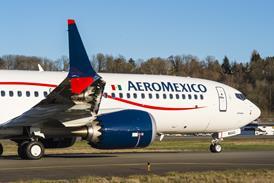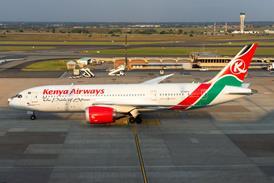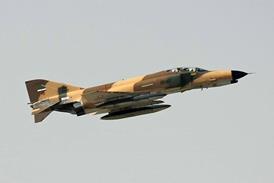Russian aviation is in crisis, as anybody who has recently passed through Moscow's Sheremetyvo Airport will have gathered. What should be an international gateway to Russia is a chaotic mix of despairing passengers, futile bureaucracy and casual corruption.
Like much else in Russia, the airport has yet to find its feet following the collapse of the Soviet system. While would-be passengers clamour to get seats on over booked peak flights, a fleet of idle aircraft, ring the airport ribbon unused. Even the occasional wild dog roams the taxiways.
The question is, can the Russian aerospace and airline industries now recover from this chaos to reinvent themselves? Some glimmers, at least, were shed on the problem at "Russian Aerospace 95", a conference held in Moscow on 25-27 April and organised jointly by Flight International and Aviaexport, the civil industry's export agency.
Perhaps for the first time, the conference brought together Russian and Western civil-aviation industries on equal terms. The overall impression was of an Eastern aerospace industry still grappling with the culture shock of joining the world market and at the start of what must be a radical, painful revolution in the way it does business.
There is a sad irony that, while the Russian aircraft industry is starved of new orders, it is sitting within one of the few airline markets in the world which is desperate to re-equip. On both sides, the cause of the stagnation is not difficult to trace. State funding has been drying up, while the economy is making only a shaky recovery. Recent success in taking annual inflation rates below the 100% mark have been greeted with jubilation.
Worse still for the aerospace sector, there is a real fear that if - and when - economic recovery does begin to feed through to the airlines, efficient Russian-built aircraft will simply not be available to take up the demand. That raises the spectre of an influx of Western types, at least in the short term.
Vladimir Ivanov, former Deputy Minister of Aviation and now deputy director of Aviaprom, a body which represents much of the aerospace industry, was not alone at the Moscow conference in issuing dire warnings that Russian aerospace was in danger of stalling.
"The industry is a very difficult situation. There is a great lack of funding, and this has worsened in the past three years," he says. Even where programmes exist, they suffer from not being allocated enough funding to be effectively developed. "The industry is virtually non-operational," laments Ivanov.
Funding aside, it is painfully obvious that there are too many designers, production plants, and "organisations", both civil and military, chasing far too few genuine programmes.
Ironically, the potentially fatal flaw for Russia's aerospace industry is its justifiable pride in its past glories. The design bureaux are not keen to give up the status which they won under Soviet rule, but their imposing buildings which line the road into the north of Moscow may give a false sense of security in an industry badly in need of downsizing and looking increasingly unsustainable.
The production plants, often deliberately placed thousands of kilometres away, are also fighting for their independent future. Despite efforts to bring design and manufacturing under a single structure, examples still abound of disagreements and political manoeuvring between the two functions. Even the question of who ultimately owns the rights to sell particular aircraft types appears hazy within Russia's fledgling civil law.
The situation is further confused by the new frontiers, which have been thrown up following the collapse of the Soviet Union. Kiev-based Antonov now finds itself across the Ukrainian border and general designer Piotr Balabuyev bemoans the lack of formal ties with his Russian manufacturing plants and customers.
WORK IS GOING ON
Balabuyev says that work is going on to create new consortia between CIS states, but warns that this will need inter-governmental co-operation.
Alexander Bobryshev of the Novosibirsk aircraft manufacturing operation, which is now building the Anotonov An-38 twin-turboprop, echoes the concerns. "There is a certain amount of co-operation at the level of aircraft production, but no formal legal framework. This should be raised at Government level," he says, admitting that the dispersal of production and design bureaux was largely an "artificially created" throwback to Soviet times.
Despite the crushing need for sweeping rationalisation throughout the industry, there seems little appetite for radical change among the main airframe design bureaux: Beriev, Ilyushin, Mikoyan, Myasichev, Sukhoi, Tupolev and Yakovlev.
Beriev, under Alexander Klimov, and Yakovlev, under the lead of chairman Alexander Dundukov, appear to have begun to throw off the inertia and started to give more focus to their ambitions. Both are gradually abandoning prestigious defence work to concentrate on more practical, entrepreneurial programmes.
With the exception of the Yak-130 military trainer programme being offered to the air force, Yakovlev has abandoned the military sector. Its Yak-41 Freestyle advanced short take-off and vertical landing fighter and the Yak-44 airborne early-warning aircraft were axed as the USSR fell apart. If it loses the air force competition to Mikoyan, its days as a military-aircraft manufacturer will be over.
Dundukov has pushed Yakovlev's light sports aircraft range to provide sorely needed hard currency as a route to financing its medium-range passenger-aircraft programmes.
Beriev has also focused its attentions away from the military sector. Its A-50 Albatross maritime patrol amphibian may never enter service with the Russian naval aviation, but it has used this project as the basis for its Be-200 civil amphibian.
SCRAPING THE SURFACE
Even these moves barely scrape the surface. The Russian aircraft industry has hardly begun to tackle the issues of over-capacity and poor productivity. The problem, if it is seen, is rarely discussed in public. With counterparts in Western Europe and the USA still going full throttle on down-sizing, the gap that Russia must fill is, if anything, growing.
The gap has partially been masked by the cheap labour and low costs available to Russian businesses, but, as Eastern Europe discovered, wages can rise dramatically once economic and currency stability begin to set in.
The loss of some of the famous design bureaux and production plants seems inevitable, but none will voluntarily consign themselves to extinction. The state will need to play the key role in pushing through an unpopular restructuring package, which will result in the loss of plants and jobs.
So far, there has been little sign that the Government is willing to be so proactive. The process may yet happen by default, however, as continuing under funding drives elements of the industry out of business. A salutary message was sent out early this year when the Samara production plant, famous for producing the Tu-154 and Tu-95 Bear, filed for bankruptcy.
Mikoyan, one of the greatest names in fighter design, is dependent on two uncertain programmes for its future. Its next-generation fighter programme, Article 42, is much delayed and has yet to fly, while its victory in the trainer competition for the air force with the MiG-AT is far from assured. So far its dalliance with the civil sector has proved fruitless.
The bureau, like many of the others, has also been hemorrhaging quality personnel attracted by considerably larger 'salaries' in the free market.
"We have got no orders, so there are no salaries," says Ivanov, speaking on behalf of Aviaprom. "People have started to look for other job opportunities, resulting in a lack of skilled personnel." Certain capabilities, he believes have already been lost. Like many of his colleagues, Ivanov wants the government to be far more supportive of the industry.
The perilous task of attempting to hold the industry together long enough to benefit from better times ahead, is highlighted by the engine sector. While on the one hand attempting to defend against heavy criticism of its record of producing inefficient and costly engines, on the other it issues stern warnings to government that improvements cannot be made without an increase in funds.
At the heart of the debate is the Aviadvigatel-designed and Perm-built PS-90A turbofan. The engine, which is the only series-produced turbofan in Russia, is crucial to the attempt to renew the Russian-built fleet, but has so far shown few signs of living up to design specifications.
Victor Chuiko, the combative president of the CIS' aero-engine manufacturers association, ASSAD, is shrilly critical of what he sees as politically motivated attacks on the performance of the PS-90A. Western efforts to put realistic figures on the engine's performance are dismissed as a plot to "implant foreign engines".
Aviadvigatel and Perm are equally stern on Western criticism, claiming that much of the in-service data circulating on the PS-90A is misleading since it relates to early production engines which have been in storage for up to three years and are only now beginning to be flown. The manufacturer produced 45 engines in 1992, but turned out just two in 1994 and none so far in 1995.
The deputy general designer at Aviadvigatel, Alexander Inozentsev, argues that the PS-90A compares well against similar Western engines such as the PW2000 family of its potential partner Pratt & Whitney. The Russian engine's fuel consumption is only 3.5% higher than that of the PW2000 and the figures for the PS-90P, the upgraded engine being planned in conjunction with P&W, will be identical, he says.
He goes on to claim that although the PS-90A was certificated on the basis of only 2,500h mean time between failures (MTBF), it is capable of reaching 25,000h MTBF, or 8,000 cycle lives, to match PW2000 levels.
Western observers remain to be convinced, as do some Russian airlines. One carrier, which is flying relatively recent examples of the engines, admits that it is obtaining extremely short life cycles from its PS-90A.
Meanwhile, Perm is also struggling to reshape its operations following the manufacturer's early privatisation. Coopers & Lybrand, the UK consultancy called in to draw up a restructuring plan, proposes dividing the vast plant, three of these would be outside aerospace, covering products such as agricultural tractors, into six clear divisions. There could be "investment potential" for $100-150 million in the near term, with more to come as the restructuring continues over the next 5-10 years, believes the consultancy.
Although, apparently a modest proposal this restructuring has raised fears within Russia, of job cuts and the breakup of the company.
Coopers & Lybrand also admit, that the partnership talks with P&W, have been moving slowly. "Negotiations have been going on for months, but the only result to date has been a co-operative agreement between Aviadvigatel and Pratt &Whitney," says the consultancy. The latest proposal is to create a separate company, together with Perm, to build and manage the PS-90 family. Whether this will overcome tensions between designer and manufacturer, while still keeping P&W on board, remain to be seen, however.
ENGINE RELIABILITY
Similar problems over engine reliability have also dogged the otherwise successful Antonov An-124 Ruslan heavy transport. The aircraft's Progress D-18T engines manufactured by Zaporozhe have had an "unacceptably high number of failures" says Chris Foyle, managing director at Air Foyle, which is operating the aircraft in partnership with Antonov.
Retrofitting Western engines is being seriously considered if enough aircraft can be found to make it cost-effective, he says. Meanwhile, the process of persuading design bureau and manufacturer to make their own improvements continues.
Although the airframe manufacturers have had less criticism, an inability to meet demand is also true of the aircraft-production plants. "Aeroflot may need 20 Ilyushin Il-96s wide-bodies, but the Voronezh production plant can only produce eight," points out Valentin Sushko, chairman of Russia's Aviation Register.
Until Russian manufacturers can fulfil these requirements with competitive aircraft, there will be a great temptation for at least the larger airlines to purchase from the West.
While some of Sushko's contemporaries would also like to see the Government introduce clear protectionist measures against Western manufacturers selling into the Russian market, he is more guarded. "If the airlines die, then the aircraft companies will perish with them," he warns.
Airbus market development manager Didier Lenormand estimates that there are more than 900 ageing Russian jet aircraft in the fleet which will be over 20 years old by the turn of the century, and require urgent replacement. Given Western levels of utilisation and a revival in load factors, there will be a requirement for only around 400 modern replacement aircraft, he believes.
Whether all of these can be Russian aircraft is doubtful on present evidence, he suggests. Of the leading contenders, only seven Tu-204s and three Il-96s were produced in 1994. Lenormand believes that Western aircraft will "...help to fill the capacity gap".
The Airbus estimates are based on a conservative estimate of 4.8% passenger traffic growth over the next five years (4% domestic and 7% international).
Others within Russia argue that demand could be much higher, especially as the domestic market recovers from the collapse it suffered following the break-up of the Soviet Union. If the demand is indeed closer to the double-digit growth being predicted by the Russian authorities, then the demand for new aircraft, including Western, will be still more intense.
Vadim Zamotin, who heads the Russian civil-aviation department, points out that Western aircraft have already given the edge to foreign carriers on international routes. "About 40% of domestic passengers flying abroad prefer to obtain the services of foreign airlines," he says.
If the penetration of the Russian market by Western aircraft, is not to have a destabilising effect out of proportion to the small numbers actually acquired, the Government needs to bolster Russia's indigenous efforts.
FEDERAL PROGRAMme
Russia's "Federal Programme of Civil Aviation Technique Development up to 2000" outlines support for some key programmes: the Ilyushin 96-300 widebody, Ilyushin Il-114 twin turboprop, Tupolev Tu-204 twin turbofan, Tu-334 twin turbofan, updated Yakovlev Yak-42M regional turbofan, Yak-48 business jet, Antonov An-38 twin turboprop, An-74 transport, and An-70T transport aircraft.
This plan is adequate, but it is clear the even these "priority" programmes are not receiving enough funding. To compound this, the design bureaux continue to insist on frittering away precious funding on non-core projects, which are unlikely to prove fruitful in the current climate.
For instance, Tupolev is working on the Tu-330 transport, various developments of the Tu-204, while Ilyushin is working on the Il-106 military transport, and twin-engine derivatives of the Il-96.
The Government in exchange for meeting the full funding needs of the core programmes could insist that others are dropped, but in the present climate that seems a remote prospect.
Some central organisation, whether governmental or not, will also be needed to force the pace of restructuring to streamline the industry around a reduced number of integrated aircraft producers.
The unanswerable question remains: will this happen in time to save the industry, or will the Government continue to fiddle while one of the pillars of the former Soviet Empire collapses?
Source: Flight International




















